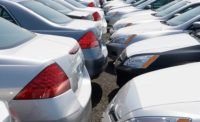Market Trends
Auto, Packaging, Construction Lead Adhesives and Sealants Market Growth
The adhesives and sealants industry is seeing growth opportunities in many end-use sectors.

The adhesives and sealants market is forecast to exceed $40 billion and $9.5 billion by 2023, respectively, according to a recent report from Global Market Insights Inc. Automotive, packaging and construction have traditionally been high consumption application avenues for the industry. Technology innovation focused on smart and sustainable product solutions could see over 4.5% compound annual growth rate (CAGR) by 2023.
Chinese construction spending was approximately $1.7 trillion in 2013, while India spent approximately $426.5 billion in the same year. A significant chunk of this spending was for the infrastructure, construction and automotive industries, which is likely to impact adhesives and sealants market size. Flooring, insulation, panel and partitions, roofing, facades, fire protection, and IG units are some notable industry application avenues. Growth in infrastructure development, driven by positive economic indicators, will directly influence adhesives and sealants industry demand.
Global automobile production was estimated at approximately 89.7 million units in 2014 and is likely to cross 100 million units by 2018. Increasing plastic and polymer use in vehicles, in order to reduce weight for enhancing efficiency, will most likely drive adhesives and sealants market size, with growth expectations of 4.9% and 5.9% from 2016 to 2023, respectively.
A high degree of regulatory intervention, particularly for toxic residue and environmental impact, could challenge product penetration and pressurize profitability. Raw materials are predominantly synthetic and petro-based, and have significant impact on adhesives and sealants market price trends.
A strong R&D focus to develop and commercialize the bio-adhesive market, using novel feedstocks such as soybean polyols, vegetable oil polyamides, polyisoprenes and epoxies, could result in a paradigm shift and change the product matrix significantly. The bio-based adhesives market accounts for roughly 1-2% of the overall demand and may see sizable gains by 2023.
The waterborne adhesive market was valued close to $8.5 billion in 2015, and will most likely be the predominant technology by 2023. It helps in reducing volatile organic compound (VOC) emissions, thus eliminating associated costs, which is a key driving factor for demand evolution. The hot-melt adhesive market was close to 1.8 million tons in 2015 and is forecast to significantly grow up to 2023. Hot-melt adhesives have excellent adhesion properties and do not require drying, as with water- or solvent-based products, and emit low VOCs.
The acrylic adhesives industry revenue was valued at nearly $5 billion in 2015. This product has high adhesion for bonding difficult substrates and faster setting time. Acrylic-based materials are being used in the development of waterborne and heat-resistant and UV light curing technology. EVA accounted for a small chunk of the industry, with overall consumption estimated close to 470 kilo tons in 2015 and is anticipated to witness significant gains over the forecast period.
The silicone sealants market was dominant, with valuation estimated at over $2 billion in 2015. Growth in end-use industries such as construction, automobiles and machinery is likely to drive demand. Polyurethane (PU) sealants occupied a share of close to 28% in 2015 and are likely grow at below-average rates up to 2023.
Pressure-sensitive applications dominated glue demand, with valuation over $6.2 billion in 2015. These products are most commonly used with no water or heat treatment in applications such as pressure-sensitive tapes, labels, note pads and automobile trim.
Packaging applications accounted for over 20% of glue demand, with consumption over 2 million tons in 2015. Packaging applications include carton boxes, envelopes, carton closures, cups, flexible packaging, specialty packaging, bags and disposables, PU, water-based and hot melts.
Construction applications dominated the sealants market share, with revenue generated estimated at $1.5 billion in 2015. The growing construction industry, especially in BRIC nations, is expected to boost caulking products demand.
Automotive applications accounted for over 18% of caulking products demand in 2015 and are likely to witness the highest gains over the forecast period.
The Asia-Pacific (APAC) region, mainly driven by China and India adhesives and sealants domestic consumption, was dominant with valuation close to $11 billion in 2015. Growth in construction spending in China, India and Indonesia is likely to boost demand. North America, dominated by the U.S., accounted for over 20% of the total volume in 2015 and is likely to grow at a sluggish pace during the forecast period. Europe’s silicone sealants market demand was estimated over 150 KT and is likely to witness the highest gains during the forecast period. Automotive applications for caulking products in Asia-Pacific were valued at over $755 million in 2015, and are likely to grow at a faster pace over the forecast period.
For more information, visit https://www.gminsights.com.
Engineering Plastics Demand Continues to Rise
According to a recent report from Ceresana, demand for engineering plastics with special physical and chemical characteristics has been increasing more strongly than the sales of common standard plastics such as polypropylene for several years. Almost 20.3 million tons of ABS, PC, PA, PMMA, POM, PBT, SAN, and fluoropolymers were sold last year. Considering the rising demand for increasingly more efficient and lighter material, this trend is likely to strengthen further.
Acrylonitrile butadiene styrene is by far the most frequently used engineering plastic, accounting for about 40% of the total demand. More than 6 million tons were processed in 2015 in Asia-Pacific alone. Among others, ABS is used for seat components and automotive door panels; casings of electronic devices; film, pipes; and sheets in the construction industry; as well as for shower heads, toys, and other household appliances.
Worldwide, electrical and electronic applications, as well as consumer goods, are among the most important sales markets for many engineering plastics; almost 25% of global demand originates in each of these two sectors. The transportation industry is the third-largest individual market, and Ceresana expects the highest growth for this segment in upcoming years. Application in the construction industry and in consumer goods will exhibit weaker development. While the transportation segment accounts for 35% of polyamide (PA) consumption, consumer goods are the major sales market of acrylonitrile butadiene styrene (ABS).
Visit www.ceresana.com/en for additional information.
Construction Industry Driving Silicone Sealants Demand
The global silicone sealants market is expected to reach $3.5 billion by 2024, according to a recent report by Grand View Research Inc. The product reportedly is increasingly substituting various organic sealants and adhesives in construction, insulating glass, automotive, and industrial applications, due to its chemical characteristics (including resistance to chemicals and corrosion) and physical properties (e.g., water repelling and elongation.
The growing use of thermoset and radiation curing technologies in the manufacturing of the product is expected to enhance the elongation and curing capabilities, which in turn is expected to propel demand over the forecast period. In addition, the presence of established raw material suppliers with superior additives as part of their product portfolio is expected to positively impact demand.
Silicone sealants’ superior characteristics compared to organic sealants (e.g., polyurethane, polysulfide and acrylic) are expected to be the key driver for the construction market over the next eight years. However, high volatile organic compound (VOC) emissions associated with silicone sealants and a growing consumer awareness for environment safety are likely to restrain growth over the next eight years.
For more information, visit www.grandviewresearch.com.
North America, Europe Dominate Global Thermal Spray Coatings Market
The global thermal spray coatings market is expected to reach a value of $7.6 billion at the end of 2016, rising at a compound annual growth rate (CAGR) of 5.9%, according to a report by Persistence Market Research. The market was valued at $7.56 billion in 2015. Europe and North America combined are expected to account for over 50% of the value share by the end of 2016, as the regions are expected to dominate the global market through the forecast period.
Hard chrome plating and medical device coating are key applications responsible for the major chunk of revenue generation in the global market. Conventional methods had a critical impact on the environment, leading many companies to seek alternative solutions such as the thermal spray coating technique.
The demand for thermal spray coatings is expected to rise as companies look for superior surface property to extend the life of their products. However, the line-of-sight coating process has its limitations, allowing coating of the surface only in-line with the coating system. Complexity with the use of robots and the need for frequent adjustments is expected to restrain the market through the forecast period due to the resulting high running costs.
On the basis of material type, the global thermal spray coatings market is segmented into: metals, alloys, carbides, ceramics, intermetallics and others. The metals, alloys and carbides segments are expected to account for over 50% value share at the end of 2016. The ceramics segment is expected to dominate the global market in terms of revenue through the forecast period.
In terms of process type, the global market for thermal spray coatings is segmented into conventional flame spray, plasma spray, high-oxygen-oxy-fuel (HVOF), and cold spray. The cold spray segment is expected to grow with double-digit CAGR through the forecast period due to its ability to deposit a wide range of materials on the substrate, especially temperature-sensitive materials.
In terms of application, the global thermal spray coatings market is segmented into aerospace, industrial gas turbines, automotive, medical and others. The aerospace segment is expected to reach a value of $4.7 billion by the end of 2024, with a market value of 37.4%. The industrial gas turbines segment is expected to grow fastest through the forecast period, owing to rising demand for high-performance turbines and engines.
On the basis of region, the market is segmented into North America, Asia-Pacific, Latin America, Europe, and the Middle East and Africa. North America was the dominating region, with over 29.3% volume share in the global market in 2015. Europe accounted for 25% market share in 2015, following North America with second-highest share. Asia-Pacific is expected to be the fastest-growing region in terms of value at the end of the forecast period.
Visit www.persistencemarketresearch.com for additional details. ASI
Looking for a reprint of this article?
From high-res PDFs to custom plaques, order your copy today!





